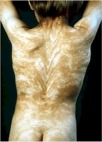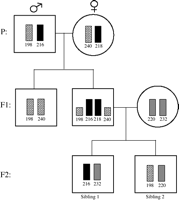Humans

The prevalence of natural chimerism in humans is far less common than in other animals. Scientists and researchers believe chimerism happens in humans when fraternal twins fuse together. The end result of the fused twin is either male, female, or a hermaphroditic individual. Most people with chimerism do not know they are chimeric because there are few physical characteristics expressed. The most severe is blaschko's lines, a tiger like striping of the skin, as seen in the image on the left. The other physical characteristics expressed by chimerism are slight such as, one hitchhikers thumb and one straight thumb, hair growth on one side of the body and not on the other, and different eye colors. Even though chimerism is uncommon naturally in humans, it does occur more often with transplantations, blood transfusions, and during maternal fetal cell exchange.
Animals

Although chimerism can appear in any species it is particular prevalent in marmoset monkeys and cattle. The incidence of chimerism in marmoset monkey is an extraordinary process. A case study of twinning in these monkeys revealed that the twin's placentas fuse and they share cells and DNA. As a result each twin is made up of DNA from their sibling and themself. The remarkable thing about these monkeys is the twin siblings are capable of producing one another's offspring. The diagram to the left shows how this can occur. As pictured two marmoset monkeys mate and have twins. One of the twins has solely one type of DNA where as the other twin has two sets of DNA. When the sibling with two sets of DNA mates with a female he produces one offspring with DNA from himself and his mate and as well as one offspring with the DNA of his mate and his sibling. All in all, both offspring are a result of his sexual reproduction, but genetically one offspring is his child and his other offspring is his nephew. This occurrence gives proof to the phrase "I'll be a monkey's uncle". For more information regarding this topic please click on the link for a video regarding marmoset monkeys. Click Here for Video
Chimerism occurs in every case of fraternal twinning of a male and a female in cattle. For an unknown reason, the male fetus grows more rapidly than the female fetus in utero. As a result, the male fetus begins to produce hormones that have an impact on the female fetus. The male hormones prevent the gonad differentiation needed to become a female. Therefore from these hormones, the female fetus not only becomes chimeric but is also sterile.
The incidence of chimerism in these animals have provoked the interest of scientist to examine the prevalence of chimerism in other species.
